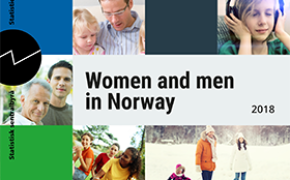The paternity leave is still popular
Published:
Over the past ten years, the proportion of the fathers’ using paternity leave quota has increased from 60 to 71 per cent, and there has been an increase in all counties. Withdrawal of the paternity quota is one of Statistics Norway’s 12 gender equality indicators.
- Full set of figures
- Indicators for gender equality in municipalities
- Series archive
- Indicators for gender equality in municipalities (archive)
Ten years ago, Statistics Norway published Indicators of gender equality in the municipalities for the first time. The indicators provide a picture of the local equality situation in Norway in 12 selected areas.
Among the 12, we see the biggest change towards more gender equality on the indicator that measures fathers' withdrawal of paternity quota and parental leave. The proportion of fathers who took out the entire paternity quota has increased by 11 percentage points since 2008, from 60 to 71 per cent (see «Calculation of the paternity quota indicator» further down in the article).
Figure 1. Selected gender equality indicators' development from 2008 to 2018
| Paternity leave | Gender distribution among leaders | Gender distribution among people with higher education | Gender distribution in private sector | Gender distribution in public sector | |
| 2018 | 0.71 | 0.73 | 0.79 | 0.74 | 0.60 |
| 2008 | 0.6 | 0.64 | 0.87 | 0.74 | 0.58 |
«Revolution of the paternity leave»
One of the purposes of this statistics, and one of the criteria for being an equality indicator in this case, is to be able to look more closely at gender equality locally - in Norwegian counties and municipalities over time. In all counties, the proportion of fathers taking out paternity leave has increased over the past ten years. The largest increase was in Hordaland, Telemark and Aust-Agder, all with 13 percentage points. The increase is also significant in Hedmark and Finnmark, but by 7 percentage points it has not been as great. In these two counties, the difference between 2008 and 2018 is the least.
Figure 2. Share of fathers taking paternity leave (the full quota or more of the total number of days for parental leave). 2008-2018
| Per cent | |
| 2008 | 59.6 |
| 2009 | 60.7 |
| 2010 | 61.7 |
| 2011 | 64.6 |
| 2012 | 68.1 |
| 2013 | 68.5 |
| 2014 | 68.2 |
| 2015 | 70 |
| 2016 | 69.7 |
| 2017 | 69.8 |
| 2018 | 70.6 |
If we look at the change in the paternity quota indicator between the last two measurement periods, from 2017 to 2018, the trend appears to be continuing. In 14 of 18 counties, there has been an increase from 2017 to 2018, albeit marginally in some counties. In Troms and Buskerud, the percentage of fathers taking out a full paternity quota has increased by 2 percentage points.
In 2018, Sogn og Fjordane (76 per cent), Akershus and the new county (from 1.1.2018) Trøndelag (74 per cent) were the three counties with the largest share of fathers taking paternity leave. Both Sogn and Fjordane and Akershus were at the top when it came to the proportion of fathers who took full paternity leave also in 2008. In Sogn and Fjordane, 18 out of 26 municipalities were above the national average in 2018. The corresponding figure for Akershus was 17 out of 21 municipalities, but there are some municipalities with very high average in Sogn og Fjordane.
The gender gap in educational level continues to increase
The indicator that has changed most towards less gender equality in the last ten years is the ratio of the proportion of women to men with higher education.
In parallel with the fact that the level of education in the population has increased for both sexes over a ten-year period, the gap between the proportion of women and men with higher education has also increased. The reason is that the group of women with higher education is growing faster than the group of men with higher education. The difference between men and women on this indicator in 2008 was 3 percentage points on average for the whole country, while the difference in 2018 was 8 percentage points.
From figure 3 we can see that there was the least gender difference in the proportion with higher education in Oslo and Akershus in both 2008 and 2018. In Oslo, 53 per cent women and 49 per cent men had higher education in 2018, while in Akershus the corresponding proportion was 41 and 35 percent.
1 Januart 1st 2018 Sør-Trøndelag and Nord-Trøndelag were merged into Trøndelag. The two previous counties are taken out of the figure. For Trøndelag, the score is shown for 2018. Previous results for Nord- and Sør-Trøndelag can be found in the StatBank for 2008-2017
Figure 3. The ratio between the proportion of women and men with higher education, by county. 2008 and 2018
| 2018 | 2008 | |
| Finnmark | 0.58 | 0.62 |
| Sogn og Fjordane | 0.65 | 0.73 |
| Oppland | 0.69 | 0.77 |
| Møre og Romsdal | 0.70 | 0.79 |
| Hedmark | 0.70 | 0.78 |
| Nordland | 0.70 | 0.79 |
| Troms | 0.71 | 0.78 |
| Telemark | 0.73 | 0.83 |
| Aust-Agder | 0.76 | 0.85 |
| Rogaland | 0.76 | 0.84 |
| Vest-Agder | 0.76 | 0.86 |
| Østfold | 0.76 | 0.87 |
| Trøndelag | 0.78 | |
| Hordaland | 0.78 | 0.86 |
| Buskerud | 0.80 | 0.93 |
| Vestfold | 0.80 | 0.91 |
| Akershus | 0.85 | 0.96 |
| Oslo | 0.91 | 0.96 |
In 2018, the gender difference between the proportion of women and the proportion of men with higher education was greatest in Finnmark and Sogn and Fjordane, which means that these two counties also have the lowest scores. In Finnmark, 35 per cent women had higher education, compared to 21 per cent men in 2018. Finnmark and Sogn and Fjordane scored the lowest on this indicator also in 2008, together with Nord-Trøndelag (-2017).
Gendered labor market, but in 1 out of 4 managers in Oslo are women
Many of the indicators measure gender equality in the labor market. For example, the proportion of men and women in the workforce, part-time work, gender distribution in the public and private sector and gender distribution among managers.
Many of these indicators have not changed very much over the last ten years, which may indicate that gender segregation in working life is still quite skewed. Women still dominate in the public sector and men in the private sector, the degree of gender balanced business structure is still skewed and the proportion of women working part-time is far greater than the proportion of men working part-time.
The exception among the «labor market indicators» is the gender distribution among managers, which has become more balanced over the last ten years. In 2018, there were 4 percentage points more female leaders than in 2008 on average for the entire country. In Oslo, 40 per cent of employees in management positions were women in 2018. This is the first time a county has over 40 per cent female managers. Nordland and Sogn and Fjordane are also close to 40 per cent in the share of female managers among employees.
Contact
-
Karin Hamre
-
Statistics Norway's Information Centre


